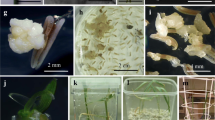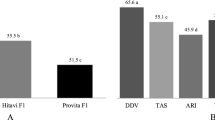Abstract
The aim of this study was to determine the effect of genotype and induction medium in anther culture of wheat (Triticum aestivum L.). Ten F1 winter wheat genotypes were tested in anther culture (AC) to compare the two most frequently applied induction media (W14mf and P4mf). Androgenesis was induced during the treatment of each tested genotypes and green plants were produced from them using both media. Based on statistical analysis, the genotypes significantly influenced (at the 0.001 probability level) the efficiency of AC (embryo-like structures (ELS), albinos, green plantlets and transplanted plantlets) and the media also had a significant effect on the number of ELS and albino plantlets. Both media can be used for AC in wheat doubled haploid (DH) plant production. The production of ELS and green plantlets was higher in P4mf medium (48.84 ELS/100 anthers, 4.82 green plantlets/100 anthers) than in W14mf medium (28.14 ELS/100 anthers, 4.59 green plantlets/100 anthers). However, the green plant regeneration efficiency of the microspore-derived structures was 16.9% when using W14mf medium, while this value was 9.6% in the case of ELS induced with P4mf medium. The application of W14mf medium thus proved to be time- and labour-saving medium in the large-scale production of DH wheat plants. In our experiments, 267 DH plants were produced for our winter wheat breeding program. The spontaneous rediploidization rate was 32.72%.
Similar content being viewed by others
References
Lantos, C., Weyen, J., Orsini, J.M., et al., Efficient application of in vitro anther culture for different European winter wheat (Triticum aestivum L.) breeding programs, Plant Breed., 2013, vol. 132, pp. 149–154.
Niu, Z.X., Jiang A.X., Abu Hammad, W., et al., Review of doubled haploid production in durum and common wheat through wheat × maize hybridization, Plant Breed., 2014, vol. 133, pp. 313–320.
Castillo, A.M., Sanchez-Diaz, R.A., and Valles, M.P., Effect of ovary induction on bread wheat anther culture: ovary genotype and developmental stage, and candidate gene association, Front. Plant Sci., 2015, vol. 6, article number 402. doi 10.3389/fpls.2015.00402
Asif, M., Eudes, F., Randhawa, H., et al., Induction medium osmolality improves microspore embryogenesis in wheat and triticale, In Vitro Cell Dev.-Pl., 2014, vol. 50, pp. 121–126.
Ouyang, J.W., Hu, H., Chuang, C.C., and Tseng, C.C., Induction of pollen plants from anthers of Triticum aestivum L. cultured in vitro, Sci. Sin., 1973, vol. 16, pp. 79–95.
Picard, E. and De Buyser, J., Obtention de plantlets haploides de Triticum aestivum L. á partir de cultures d’anthéres in vitro, Compt. Rend. Acad. Sci. Paris, 1973, vol. 277, pp. 1463–1466.
Wang, C.C., Chu, C.C., Sun, C.S., et al., The androgenesis in wheat (Triticum aestivum L.) anthers cultured in vitro, Acta Genet. Sin., 1973, vol. 16, pp. 218–222.
Hu, D.F., Yuan, Z.D., Tang, Y.L., and Liu, J.P., “Jinghua No-1” a winter-wheat variety derived from pollen sporophyte, Sci. Sin., Ser. B: Chem. Biol. Agric. Med. Earth Sci., 1986, vol. 29, pp. 733–745.
De Buyser, J., Henry, Y., Lonnet, P., et al., Florin—a doubled haploid wheat variety developed by the anther culture method, Plant Breed., 1987, vol. 98, pp. 53–56.
Pauk, J., Kertész, Z., Beke, B., et al., New winterwheat variety—“GK Délibáb” developed via combining conventional breeding and in vitro androgenesis, Cereal Res. Commun., 1995, vol. 23, pp. 251–256.
Graf, R. J., Hucl, P., Orshinsky, B.R., and Kartha, K.K., “McKenzi” hard red spring wheat, Can. J. Plant Sci., 2003, vol. 83, pp. 565–569.
Sadasivaiah, R.S., Perkovic, S.M., Pearson, C., et al., Registration of “AC Andrew” wheat, Crop Sci., 2004, vol. 44, pp. 696–697.
Longin, C.F.H., Mi, X., Melchinger, A.E., et al., Optimum allocation of test resources and comparison of breeding strategies for hybrid wheat, Theor. Appl. Genet., 2014, vol. 127, pp. 2117–2126.
Jia, G., Chen, P.D., Qin, G.J., et al., QTLs for Fusarium head blight response in a wheat DH population of Wangshuibai/Alondra’s’, Euphytica, 2005, vol. 146, pp. 183–191.
Szabó-Hevér, Á, Lehoczki-Krsjak, S, Varga, M., et al., Differential influence of QTL linked to Fusarium head blight, Fusarium-damaged kernel, deoxynivalenol contents and associated morphological traits in a Frontanaderived population, Euphytica, 2014, vol. 200, pp. 9–26.
Cuthbert, J.L., Somers, D.J., Brule-Babel., et al., Molecular mapping of quantitative trait loci for yield and yield components in spring wheat (Triticum aestivum L.), Theor. Appl. Genet., 2008, vol. 117, pp. 595–608.
Zhang, K.P., Tian, J.C., Zhao, L., and Wang, S.S., Mapping QTLs with epistatic effects and QTL × environment interactions for plant height using a doubled haploid population in cultivated wheat, J. Genet. Genomics, 2008, vol. 35, pp. 119–127.
Jauhar, P.P., Xu, S.S., and Baezinger, P.S., Haploidy in cultivated wheats: induction and utility in basic and applied research, Crop Sci., 2009, vol. 49, pp. 737–755.
Islam, S.M.S., and Tuteja, N., Enhancement of androgenesis by abiotic stress and other pretreatments in major crop species, Plant Sci., 2012, vol. 182, pp. 134–144.
Tuvesson, S., Ljungberg, A., Johansson, N., et al., Large-scale production of wheat and triticale double haploids through the use of a single-anther culture method, Plant Breed., 2000, vol. 119, pp. 455–459.
Kondic-Spika, A., Vukosavljev, M., Kobiljski, B., and Hhristov, N., Relationship among androgenetic components in wheat and their responses to the environment, J. Biol. Res.—Thessalon., 2011, vol. 16, pp. 217–223.
He, D.G., and Ouyang, J.W., Callus and plantlet formation from cultured wheat anthers different developmental stages, Plant Sci. Lett., 1984, vol. 33, pp. 71–79.
Broughton, S., Ovary co-culture improves embryo and green plant production in anther culture of Australian spring wheat (Triticum aestivum L.), Plant. Cell Tiss. Org., 2008, vol. 95, pp. 185–195.
Redha, A., and Talaat, A., Improvement of green plant regeneration by manipulation of anther culture induction medium of hexaploid wheat, Plant Cell Tiss. Org., 2008, vol. 92, pp. 141–146.
Redha, A. and Suleman, P., Effects of exogenous application of polyamines on wheat anther cultures, Plant Cell Tiss. Org., 2011, vol. 105, pp. 345–353.
Rubtsova, M., Gnad, H., Melzer M., et al., The auxins centrophenoxine and 2,4-D differ in their effects on non-directly induced chromosome doubling in anther culture, Plant Biotechnol. Rep., 2013, vol. 7, pp. 247–255.
Zur, I., Dubas, E., Krzewska, M., and Franciszek, J., Current insights into hormonal regulation of microspore embryogenesis, Front. Plant Sci., 2015, vol. 6, article number 424. doi 10.3389/fpls.2015.00424
Pauk, J., Mihály, R., Puolimatka, M., Protocol of wheat (Triticum aestivum L.) anther culture, Doubled Haploid Production in Crop Plants, a Manual, Maluszynski, M., Kasha, K.J., Forster, B.P. and Szarejko, I., Eds., Dordrecht: Kluwer, 2003, pp. 59–64.
Ouyang, J.W., Jia, S.E., Zhang, C., et al., A new synthetic medium (W14) for wheat anther culture, Annual Report, Institute of Genetics, Beijing: Academia Sinica, 1989, pp. 91–92.
Barnabás, B., Protocol for producing doubled haploid plants from anther culture of wheat (Triticum aestivum L.), in Doubled Haploid Production in Crop Plants, a Manual, Maluszynski, M., Kasha, K.J., Forster, B.P. and Szarejko, I., Eds., Dordrecht: Kluwer, 2003, pp. 65–70.
Soriano, M., Cistué, L., Castillo, A.M., Enhanced induction of microspore embryogenesis after n-butanol treatment in wheat (Triticum aestivum L.) anther culture, Plant Cell Rep., 2008, vol. 27, pp. 805–811.
Broughton, S., The application of n-butanol improves embryo and green plant production in anther culture of Australian wheat (Triticum aestivum L.) genotypes, Crop Pasture Sci., 2011, vol. 62, pp. 813–822.
Lantos, C., Bóna, L., Boda, K., Pauk, J., Comparative analysis of in vitro anther- and isolated microspore culture in hexaploid Triticale (×Triticosecale Wittmack) for androgenic parameters, Euphytica, 2014, vol. 197, pp. 27–37.
Rather, S.A., Chaudhary, H.K., and Kaila, V., Proportional contribution and potential of maternal and paternal genotypes for polyhaploid induction in wheat x Imperata cylindrical chromosome elimination approach, Cereal Res. Commun., 2014, vol. 42, pp. 19–26.
Dunwell, J.M., Haploids in flowering plants: origin and exploitations, Plant Biotechnol. J., 2010, vol. 8, pp. 1711–1726.
Oleszczuk, S., and Lukaszewsky, A.J., The origin of unusual chromosome constitutions among newly formed allopolyploids, Am. J. Bot., 2014, vol. 101, pp. 318–326.
Ganeva, G., Landjeva, S., Belchev, I., and Koleva, L., Characterization of two wheat doubled haploid populations for resistance to common bunt and its association with agronomic traits, Cereal Res. Commun., 2014, vol. 42, pp. 484–494.
Ouyang, J.W., Liang, H., Jia, S., et al., Studies on the chromosome doubling of wheat pollen plants, Plant Sci., 1994, vol. 98, pp. 209–214.
Soriano, M., Cistué, L., Vallés, M.P., and Castillo, A.M., Effects of colchicine on anther and microspore culture of bread wheat (Triticum aestivum L.), Plant Cell Tiss. Org., 2007, vol. 91, pp. 225–234.
Weyen, J., Barley and wheat doubled haploids in breeding., in Advances in Haploid Production in Higher Plants, Touraev, A., Forster, B.P., and Mohan Jain, S., Eds., Dordrecht: Springer Science + Business Media B.V., 2009, pp. 179–187.
Barnabás, B., Pfahler, P.L., and Kovács, G., Direct effect of colchicine on the microspore embryogenesis to produce dihaploid plants in wheat (Triticum aestivum L.), Theor. Appl. Genet., 1991, vol. 81, pp. 675–678.
Author information
Authors and Affiliations
Corresponding author
Additional information
The article is published in the original.
Rights and permissions
About this article
Cite this article
Lantos, C., Pauk, J. Anther culture as an effective tool in winter wheat (Triticum aestivum L.) breeding. Russ J Genet 52, 794–801 (2016). https://doi.org/10.1134/S102279541608007X
Received:
Published:
Issue Date:
DOI: https://doi.org/10.1134/S102279541608007X




